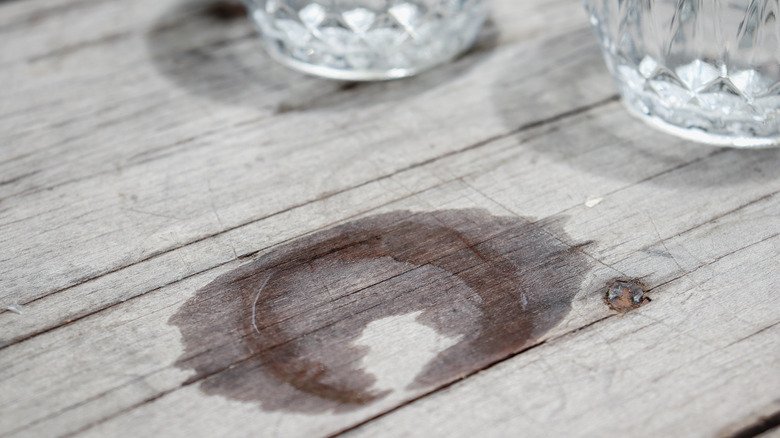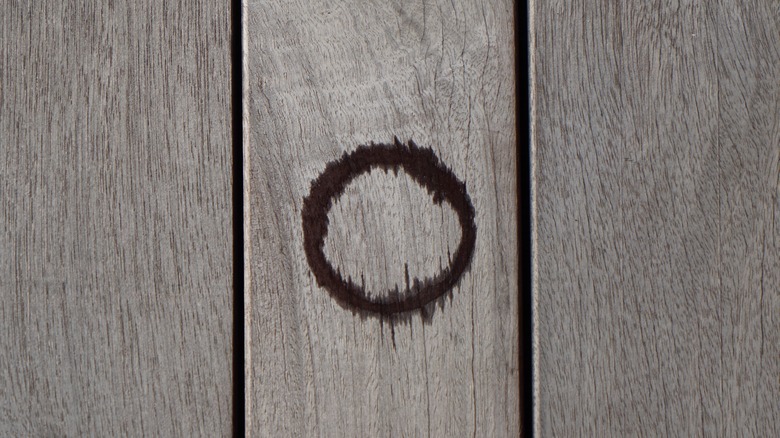Should You Use Bar Keepers Friend To Remove Water Stains From Wood?
Few cleaning issues are quite as perplexing as water-marked wood. Whether an icy glass of iced tea overstayed its welcome or you're trying to remove stains from an heirloom table, it can often seem impossible. After trying everything in your cleaning arsenal, you may be curious about using the powerful multi-use Bar Keepers Friend (BKF) on water-stained wood. Bar Keepers Friend is a lightly abrasive cleaning product that comes in both cream and powder forms. There are countless TikToks about BKF reviving stovetops, cookware, and dirty bathtubs, but can you use it on wood?
Bar Keepers Friend is only recommended for use on non-porous materials such as ceramic, glass, and stainless steel. Wood, however, is quite soft and porous, which means products can sink in and deteriorate the finish. BKF is a physical and chemical abrasive cleaner and stain remover, meaning it physically displaces buildup with the help of gritty erosives as well as oxalic acid — a naturally occurring chemical compound found in produce such as rhubarb — which can cause a bleaching effect. Unlike Ajax or Comet, BKF uses an acidic rather than alkaline formula to lighten stains. Some people swear by BKF's ability to gently remove water stains from wood, but without an official endorsement from the company, we can't authoritatively say it's safe to use on watermarks. But we can tell you the pros and cons of using BKF to remove water stains so you can make the best decision for your furniture.
The pros and cons of using BKF
Based purely on anecdotal evidence, like a before and after found on Instructables.com, BKF does seem capable of removing water marks from wood furniture, though it may take a few coats. That's likely due to its inclusion of oxalic acid, which makes up approximately 10% of BKF formulas. On its own, oxalic acid is recommended for removing water stains from wood, and while the concentrated form can probably deteriorate the stain, it can also eat the finish in some cases. Diluting it with other abrasives and minerals like in BKF means the oxalic acid can do its job as a stain remover, just not too well.
With that being said, there is still some risk even in its diluted form. Bar Keepers Friend may eat away at the wood finish and surrounding area of the stain. This can make for an uneven complexion and halo effects around the stain, which could possibly result in needing to apply the solution all over the piece and refinish the surface. After weighing out the pros and cons, BKF only seems like the right call if you're willing to put in some extra elbow grease to revive the area. Only try Bar Keepers Friend if you have tried other wood-safe solutions and want to try one last cleaning method before resorting to sanding down and refinishing the furniture. With that being said, there are some ways to minimize possible damage if you do decide to go the BKF route.
Less is probably more
BKF's two main formulas are its classic powder and cream paste. Both are similar formulas, so you could realistically use either for this application. The cream certainly has convenience on its side. The benefit of using the powder is that you can more easily dilute the formula in a slurry with water, better controlling the concentration of physical and chemical abrasives. The less product used, the less risk of excessive erosion occurring. Bar Keepers Friend also recommends using the powder form for long-term stains.
Be cautious if you choose to use steel wool to apply the BKF paste or cream to the wood, as it can easily damage the wood and leave metal particles behind.
At the end of the day, some folks say BKF is a solid choice for getting rid of water stains in wood, and we were impressed with some of the results we saw. But because it can so easily further damage the wood, it's nowhere near the top of our list of best water mark removal methods. BKF should only be thought of as a last resort, and you should still understand that you may need to further sand, stain, condition, and seal the furniture afterward to make the finish seamless.

